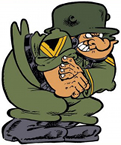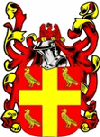el cid again
Posts: 16922
Joined: 10/10/2005
Status: offline

|
Scenario 105 RHSEOS Airborne Logic
The Doro Nawa Unit (too late planning group) formed upon mobilization reviewed the ambitious plans for Japanese Army and Navy airborne forces. Although both services were aided by the same (108 member) German military mission, each elected to take a somewhat different solution.
IJA Airborne Units: The IJA decided to create a unified command for both the ground units and the air units responsible to deliver them. Called the Raiding Group Command, this approach is considered superior in airborne theory, but no other nation ever implemented it, before or after WWII. The concept included higher command echelons, such that eventually an airborne brigade could be formed which could operate as a unified force in some operations. The highest echelon is called the Raiding Group. The Germans proposed it should consist of two Raiding Forces, two Glider Forces, an airborne Engineer Unit, an airborne Tank Unit, and an airborne Machine Cannon Unit. Each force would consist of two "regiments" (battalions). The airborne Forces, Engineer Unit and Machine Cannon Unit would be airborne. The Glider Forces and the Tank Unit would be airmobile. This concept was modified by the planning group because it would take years to implement. Since Japan sought a short war, and needed to have maximum effectiveness early in that war, it was decided not to form airmobile units at all, nor gliders to transport them. Instead, the Raiding Group would consist of three Raiding Forces, an Engineer Unit, a Machine Cannon Unit and a Recon Unit, all of which could be operational by the summer of 1942. The entire Group could be delivered by parachute. These units would be supplemented by two additional Raiding "regiments" which could operate independent of the Raiding Force from 1943. The only unit to be recast was the Recon Unit, which was similar to the Tank Unit, except equipped with different kinds of tankettes: a 37 mm armed version, a 6.5 mm MMG version, and an ammo carrier version - supplemented by Type 98 Scout Cars.
IJN Airborne Units: The IJN opted for a simplified airborne unit concept. Called Airborne SNLFs, its units were in effect slightly different versions of the Raiding "regiment" - armed with the standard weapons of Japanese SNLFs. There were no higher echelons or specialist units at all. The historical plan to create two of these units at Yokosuka was modified by the planning committed. Two additional units would be trained at the same facilities, at the cost of not forming two non-airborne SNLFs. These units would also be available in the first year of the war, when light airborne units could most contribute to the planned offensive.
JAAF Air Transport Units: Since Scenario 105 suspends the development of the Ku-8 Glider (from the Ki-34 transport plane), the Glider Regiments do not form. Instead, the fifth and sixth Raiding Sentais are formed using Ki-49II transport planes. Since this aircraft is both faster than, and has more range and capacity than the Ki-57, the first and second Raiding Sentais also upgrade to it. In addition, the 107th and 108th Transport Sentais are formed as the third and fourth Raiding Sentais, and are also assigned to the Raiding Group Command. They form on Ki-57 II s and also upgrade to Ki-49II transports. In addition, all JAAF transport Chutais and Units upgrade to using the Ki-49II when available, so they can be assigned to the Raiding Group Command and, by midwar, have the same operational speed, cargo and range. In addition, four Raiding Units are formed of 18 x Type LO or Ki-57I s in 1941 and 1942, upgrading to Ki-49II when available. Non-raiding group air transport units also are upgraded in many instances. See below.
JNAF & Civil Air Transport Units: DNKKK (the national airline) operated on a para-military basis, sometimes using the same equipment as the JNAF (see for example the H6K4-L flying boats). Like the JNAF, it also often used converted Army bombers, with different electrical and communications systems. These two services, as well as some satellite air transport units (see MKKK and the Cochin China Air Transport units as examples, others form late in the war), are integrated and slowly integrated over time, so that most units end up operating a version of the Ki-49 II transport redesignated L4M2 (since it cannot substitute in the same units, having different internal systems). The main exceptions are long range units, operating converted Navy bombers or flying boats. The DNKKK (and MKKK) are substantially reorganized and reequipped, and three new Raiding Groups (14th, 16th and 18th) come from this effort - the fourth is a slightly expanded 20th Transport Chutai (now 20th Raiding Group). The reduced number of civil air hubs are, however, expanded to full size (32 machines). As well - the civil air training program is expanded immediately, instead of waiting until later in the war. Type LO - which historically participated in air assault operations - equip one of the new Raiding Units under JAAF control. DC-3s are converted to L2D1 standard (joining 2 prototype JNAF machines) and assigned to operate in China. Except for some special cases, naval transport production is concentrated on the L2D2, similar to DC-3 and C-47 (of which it is a licensed production variant), but it carries less cargo over a longer range - important in Pacific Ocean operations. Civil air organizations concentrate initially on short range logistical support using Ki-34s converted to L1N1 standard, and upgrade to medium range operations with the Ki-49 II in L4M2 form. Unlike IRL, it is not intended civil operators will participate in air assault operations.
< Message edited by el cid again -- 5/22/2012 9:13:20 PM >
|
 Printable Version
Printable Version










 New Messages
New Messages No New Messages
No New Messages Hot Topic w/ New Messages
Hot Topic w/ New Messages Hot Topic w/o New Messages
Hot Topic w/o New Messages Locked w/ New Messages
Locked w/ New Messages Locked w/o New Messages
Locked w/o New Messages Post New Thread
Post New Thread